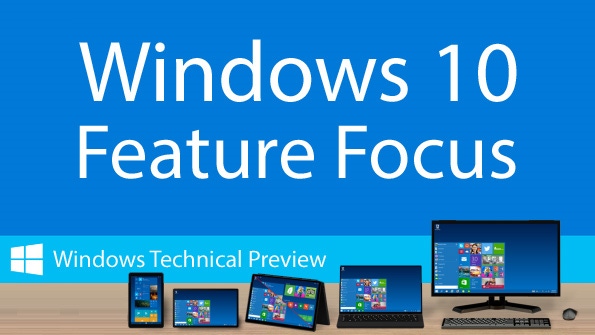Windows Technical Preview Feature Focus
Here's what's new in Windows 10
October 21, 2014

As you might expect of a major new Windows version, Windows 10 provides a number of new features and improvements over previous releases such as Windows 7 and Windows 8. In this series, I am exploring these features as they appear in the Windows Technical Preview. I'll be updating this series regularly going forward.
Note: This document was updated on October 21 to add new features in build 9860.
I'll begin rifling through this list—and adding to it—as soon as I get the Technical Preview installed on multiple PCs and devices. In the meantime, here's what I know I'll be covering up front.
Action Center. Windows 10's notification center provides and collects system and app notifications, and in future builds it will be extended with features like Quick Actions and Cleaner. You access Action Center by clicking the Action Center icon in the system notification area.
Battery Saver. One of many new Windows 10 features that debuted first in Windows Phone, Battery Saver (currently misspelled as BatterySaver in the most recent build) will limit background data transfer activity and adjust hardware settings to optimize battery life when enabled. It can be turned on manually or can be enabled automatically when battery life hits a certain level.
Command line improvements. The Windows command line has finally been updated to support standard text selection, cut, copy and paste operations and keyboard shortcuts.
Data Sense. Another feature that debuted on Windows Phone, Data Sense (misspelled as DataSense in the current build) helps monitor your data usage, which can be particularly useful for those using a metered cellular data connection.
File Explorer improvements. File Explorer has been enhanced in Windows 10 with a new Home location that provides quick access to favorite file locations, frequently-accessed folders, and recent files. There's also a new Share button on the Share tab that lets you share one or more files or folders via email, over the network, or via Universal apps like OneDrive.
Multiple desktops. In Windows 10, you can now group apps in custom desktops. You can add, access, and manage these desktops from the new Task View interface.
Preview builds. This curious feature lets you look for and then download and install new Windows Technical Preview builds. I assume it will only be available during the preview, but you can also use this feature to determine how quickly you get new features and builds: Slow (the default) or Fast (as soon as possible).
Snap improvements. Where Windows 8 offers separate Snap features for the desktop and the Modern mobile environment, Windows 10 consolidates these into a single interface while adding new features such as the ability to use a new quadrant layout and Snap Assist, which prompts you with available apps when you enter Snap mode.
Start menu. While the Windows 10 Start experience appears as a Windows 8-like Start screen on tablets, those with PCs and 2-in-1s will see the new Start menu, which looks and works much like the one in Windows 7. The Start menu also provides access to Universal app tiles, however, which can be resized and arranged as needed. And the Start menu itself can also be resized as you prefer.
Task View. The new Task View replaces Windows Flip (ALT + TAB) and the Windows 8 Switcher, providing a single, consistent interface for switching between running apps and multiple desktops, each of which can contain their owns groups of apps. You can access Task View by typing ALT + TAB or by clicking the Task View button on the taskbar.
Trackpad gestures. In addition to the trackpad gestures that debuted in Windows 8, Windows 10 will support four new three-finger gestures that are all aimed at helping you navigate between open windows, apps and virtual desktops.
Universal apps. In Windows 10, Windows Store apps are recast as Universal apps, a new breed of mobile app that runs on phones, tablets and PCs. These apps are still obtained from Windows Store but can now run alongside traditional Windows applications and web apps on the desktop, and provide access to system and app-specific commands.
Windows Feedback. Users of the Windows Technical Preview gain access to frequent build updates, participate in the Technical Preview forum, and provide feedback directly to the team at Microsoft that is creating Windows 10. The Windows Feedback app is the primary mechanism for this feedback, and it allows you to provide category-based feedback to Microsoft, or add your own notes to feedback others have provided. Microsoft will also provide notifications in Windows to ask you for feedback about specific features.
I will expand this list as new features in the Windows Technical Preview are uncovered. Let me know about any new features you've found, or about features you'd like to see covered first. Thanks! --Paul
About the Author
You May Also Like






.jpg?width=700&auto=webp&quality=80&disable=upscale)
